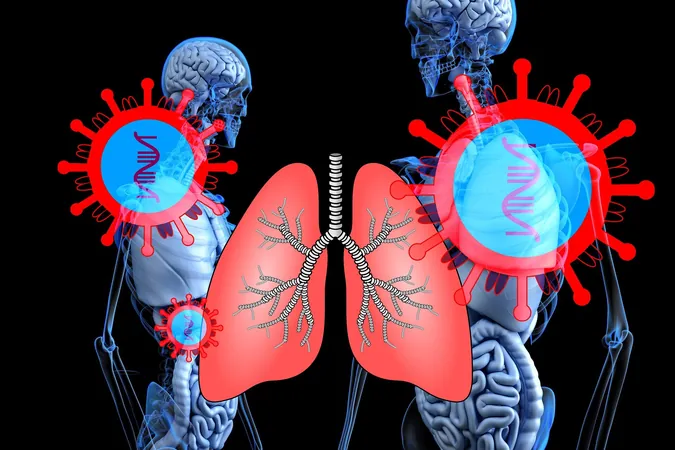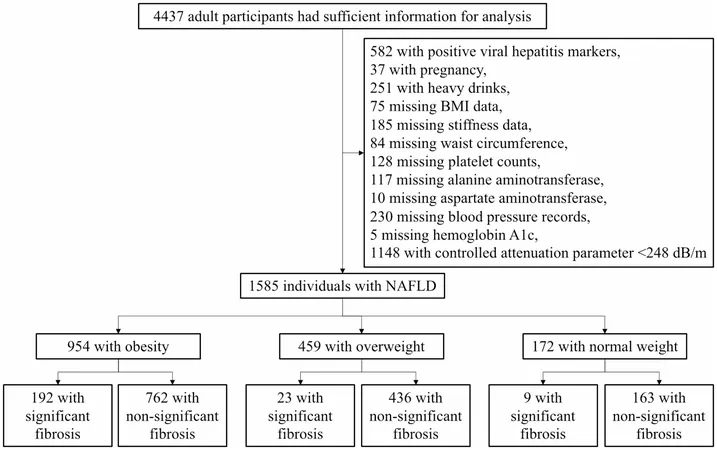
Major Breakthrough: Scientists Uncover Immune Cell Networks Behind Lethal Lung Disease
2025-03-27
Author: Nur
In a groundbreaking discovery at Rutgers Health, researchers have revealed that networks of misplaced immune cells are driving idiopathic pulmonary fibrosis (IPF), a deadly lung disease with a shocking mortality rate—80% of patients succumb within a decade. This groundbreaking research could pave the way for innovative treatments that may change the lives of countless individuals affected by this affliction.
Understanding IPF
IPF is notable for its ability to scar lung tissue, making breathing increasingly difficult and ultimately leading to severe oxygen deprivation. Current treatments are limited, offering only minimal benefits, while the option of lung transplantation comes with its own risks, including a daunting 50% mortality rate within five years of surgery.
The Research Findings
Published in the respected European Respiratory Journal, the study utilized advanced spatial mapping techniques, allowing researchers to closely examine and compare healthy lung tissues with those afflicted by fatal IPF. Their findings were striking: disease-affected lungs were found to be saturated with plasma cells—specialized immune cells known for their antibody production, which normally reside only in the bone marrow.
“What we discovered is alarming,” stated Qi Yang, associate professor at Rutgers Robert Wood Johnson Medical School and senior author of the study. “In a healthy lung, you would find almost no plasma cells. But in patients battling IPF, their lungs are inundated with these cells.”
Novel Cellular Networks
The team identified novel cellular networks that appear to drive this abnormal immune response, finding unique mural cells that encircle blood vessels and release signaling proteins to organize immune activity. Additionally, they discovered a distinctive type of fibroblast that secretes a protein attracting plasma cells to the injured areas of the lungs. “This particular fibroblast has never been observed before,” remarked Reynold Panettieri, director of the Rutgers Institute for Translational Medicine and Science and fellow senior author. “While fibroblasts are typically known for scarring in multiple organs, this specific type seems unique to the lung.”
Potential Treatment Avenues
Exploring their findings further, the researchers used live mice to determine if inhibiting plasma cell activity could slow the progression of the disease. Their work indicated that blocking critical signaling pathways diminished plasma cell accumulation and alleviated lung scarring—suggesting a novel and effective treatment avenue for humans.
What makes this research particularly exciting is that existing medications targeting plasma cells, such as those used for treating multiple myeloma, a cancer of plasma cells, could be repurposed to combat IPF. “If these plasma cells are responsible for producing harmful antibodies, we might need to eliminate them to stop the disease in its tracks,” Yang explained.
The Role of Antibodies
Previous studies have already highlighted an abnormal increase in antibody responses among IPF patients, illustrating the potential role these antibodies play in driving tissue damage. The new research sheds light on how these aberrant antibody-producing cells accumulate in the lungs and contributes to disease progression.
Experts suggest that the antibodies may spur tissue damage through various mechanisms, including the activation of transforming growth factor-beta from pulmonary macrophages, thereby promoting fibrosis. “The identification of this unique cell presents an exciting opportunity. We are hopeful we can influence this specific cell without disrupting other fibroblasts critical for normal tissue repair,” said Panettieri.
Hope for the Future
With IPF primarily affecting men over the age of 60, and with a majority of patients not surviving longer than five years post-diagnosis, these findings offer renewed hope for developing effective treatments in a field largely devoid of therapeutic options.
Future Research
Looking ahead, the research team aims to further investigate whether these plasma cells produce autoantibodies that target healthy lung tissue and how the mural cells and fibroblasts develop their abnormal characteristics in IPF.
“This research supports the notion that IPF may have a strong autoimmune component,” Yang concluded, hinting at a significant shift in understanding this complex disease.
Conclusion
Stay tuned! This eye-opening study not only highlights the intricate battle within the lungs of IPF patients but also illuminates a potential path to revolutionary treatments that could save lives.


 Brasil (PT)
Brasil (PT)
 Canada (EN)
Canada (EN)
 Chile (ES)
Chile (ES)
 Česko (CS)
Česko (CS)
 대한민국 (KO)
대한민국 (KO)
 España (ES)
España (ES)
 France (FR)
France (FR)
 Hong Kong (EN)
Hong Kong (EN)
 Italia (IT)
Italia (IT)
 日本 (JA)
日本 (JA)
 Magyarország (HU)
Magyarország (HU)
 Norge (NO)
Norge (NO)
 Polska (PL)
Polska (PL)
 Schweiz (DE)
Schweiz (DE)
 Singapore (EN)
Singapore (EN)
 Sverige (SV)
Sverige (SV)
 Suomi (FI)
Suomi (FI)
 Türkiye (TR)
Türkiye (TR)
 الإمارات العربية المتحدة (AR)
الإمارات العربية المتحدة (AR)